Got Ticks? A research team from the University of Oklahoma is assessing Oklahoma’s tick population. Be a part of their study by sharing photos and sighting details on iNaturalist, a free nature-sharing platform. (If the tick is attached, be sure to share the location where you likely picked up the tick, not your location when you discovered the tick bite.) In addition to documenting tick sightings from across the state, the research team is sweeping 13 Oklahoma City parks to learn more about tick prevalence in urban areas and of any pathogens they may carry.
By collecting tick data from various locations across the state, a comprehensive map of tick species distribution can be created. This mapping can provide valuable insights into the geographical spread of ticks, including identifying areas where certain species are more prevalent. Monitoring tick populations over time can help identify changes in tick abundance or the emergence of new tick species.
When Jes Farquhar’s family moved from Arizona to Oklahoma, she had one big concern: ticks. A decade later, Farquhar had overcome her apprehensions and was a graduate researcher with Oklahoma State University studying the ticks that parasitized black bears.
“Once I started researching ticks, I developed a respect for them,” Farquhar said. “They’re not my favorite, and I certainly don’t want a tick bite, but they’re fascinating animals.”
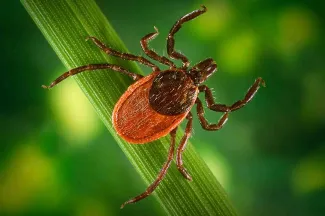
The female black-legged tick is one of eight Oklahoma tick species of medical or veterinary importance. It’s also one of Farquhar’s favorite species, reminding her of an elegant lady in a black dress.
Farquhar said ticks play three main roles in our ecosystem.
“First, they’re a food source. We know different reptiles, amphibians, and birds feed on them. Second, they can serve as a type of natural control for wildlife populations because they can carry and transmit diseases. Third, they can be thought of as an ecological indicator of other wildlife populations and their relationships. An increase in the tick population could indicate an increase in a host (species), like mice. That increase could be due to a decrease in predators, like snakes or carnivores.”
Fast Facts
by Melissa Marquez, University of Oklahoma graduate student
- Ticks use various cues to identify a potential host, including body heat, movement, and the release of carbon dioxide.
- Some tick species can survive without feeding for up to three years.
- Tick saliva contains an anesthetic, which helps them go unnoticed while they are feeding on the host. Anticoagulant compounds are also found in tick saliva, preventing the host’s blood from clotting during feeding. This allows the tick to obtain a continuous blood meal.
- Some species, including the longhorn tick, can reproduce through parthenogenesis, which means they can lay fertile eggs without mating.
- Ticks can transmit multiple diseases to a single host in a single feeding session. If a tick is carrying multiple pathogens, all of them can potentially be transmitted to the host during the blood meal.
The Tick Life Cycle
As part of her early research, Farquhar learned about the ecology of Oklahoma’s ticks and their different stages of life.
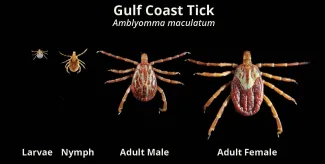
Ticks have four basic life stages; cycling from the egg to a six-legged larva or seed tick, to an eight-legged nymph, and finally to an adult.
“There are a few alternate life cycles, but the normal process starts when a batch of eggs hatches into the larval form, or seed ticks. Sometimes we call this mass of seed ticks a tick bomb. If you walk by the tick bomb, you can get hundreds of tiny ticks on you.”
Once the larva, or seed tick, finds a host it takes a blood meal. Larva can remain attached to the host for about three days if left undisturbed.
“Ticks secrete a cement of sorts that helps them stay attached to the host for the entire feeding period. When seed ticks are done feeding, they drop off and find a dark, moist place to hide and molt into nymphs.”
Similar to the larval tick, the nymph must find a host and take a blood meal. Nymphs can feed for three or four days if left undisturbed. Once they drop off the host, they again molt and become adults.
“Just like the larval and nymph stages, the adult tick must also take a blood meal. Once the adult finds a host, it feeds for seven to 10 days if undisturbed. During this time, females produce a lot of pheromones to attract a male tick and eventually mate. Once the mated female completes its meal, it drops off the host, lays eggs, and dies.”
Two Clues for Identification
“When I’m identifying a tick, I use two main characteristics. I look at the coloration and patterning on the back, and the length of the mouthparts. Shape isn’t very helpful in identification because it changes based on the amount the tick has fed. Even a slightly fed tick will start to expand.”
“Hard ticks” are the most likely encountered group. These ticks have a hard but expandable outer layer that protects their organs. A dorsal shield, or scutum, further covers the back. The coloration and patterning on the shield differ among species and sexes, and shield size varies between males and females.
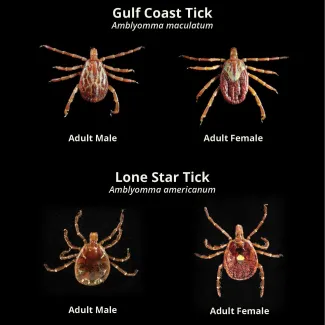
The coloration and size of the dorsal shield can help in identification. The shield of both male and female Gulf Coast ticks (top) are mottled whereas the shield of a male lone star tick (bottom left) is mostly unmarked with white dots on the bottom edge, and the shield of a female lone star tick (bottom right) is marked with a single dot at the base of the shield. The shield covers the majority of the body in males of both species and only covers the front of the body in females of both species.
Ticks are arachnids, more closely related to spiders than they are to insects. Unlike insects, ticks do not have a segmented body and lack a distinct head. Instead, what we think of as the head are actually mouthparts.
“After I’ve looked at the coloration and patterning on the dorsal shield, I typically look at the length of the mouthparts. The American dog tick has really short and blunted mouthparts, while the lone star tick has longer mouthparts.”
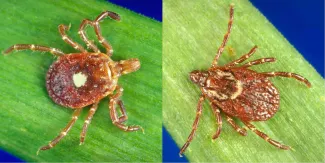
The female lone star tick (left) has longer mouthparts than a female American dog tick (right).
A Note on Female Ticks
“When I was growing up, I thought a fully fed female was a different species than the little bitty ticks. I just lumped all the fully fed females together as a single species.”
Instead, a fully fed female of one species can appear similar to a fully fed female of another species. And a fully fed female can appear different than an unfed female of the same species.
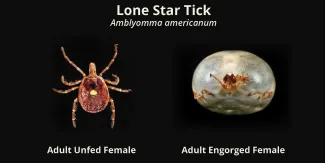
Female lone star ticks; an unfed female (left) and an engorged female (right). The dorsal shield with characteristic spot is visible just above the mouthparts of the engorged female. A small number of eggs are also visible near the mouthparts of the engorged female.
Tips for Avoiding Ticks
“It’s not fashionable, but I recommend tucking your pants into knee high socks when in medium to tall grass or in wooded habitats. This can help keep ticks from gaining access to your skin.”
In addition to tucking shirts into pants and pants into socks, outdoor adventures can also wear light colored clothing to help make crawling ticks more visible. They can then be removed from the clothing before they can attach to the skin.
“If you know you’re going into a heavily infested area, spray yourself down. You can also treat your clothes to help repel ticks.”
Repellants containing DEET can be applied on the skin or on the clothes while permethrin should only be applied to clothes and shoes and allowed to completely dry before use.
“My advice to those that venture into tick prone areas is to do a thorough tick check. If you do have an attached tick, remove it as quickly as possible by grasping the tick close to the skin and slowly pulling backwards. If you have any concerns about the tick bite, check with your doctor."
“When you’re growing up, you learn more about mammals and birds and reptiles, so ticks are completely alien. Learning about ticks is a bit like peeling back the onion. Once you start studying arachnids and insects, it opens a whole new world.”